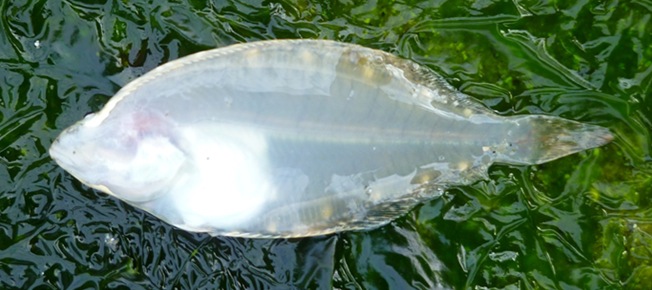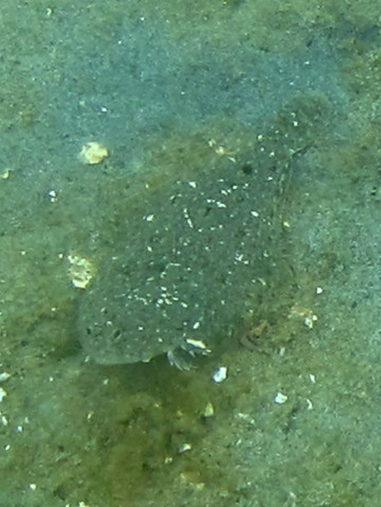Speckled sanddab, Catalina sand dab • Citharichthys stigmaeus
Identification
This sand flounder (Family Paralichthyidae) camouflages well against the sandy ocean floor. Both eyes are on its left side, which is tan to olive and speckled with brown, grey, and black. The side that rests on the floor is cream. It has short pectoral fins, and unlike some other flounders it does not have a ridge above its lower eye. Click here for more detailed identification information.
Habitat & Range
The speckled sanddab shuffles into the sand to cover and camouflage itself. It can be difficult to notice unless it moves. It is most common at depths of less than 15 m, though it has been recorded at over 350 m deep. It is found in sandy-bottomed coastal waters from the Gulf of Alaska to southern Baja California.
Similar Species
The Pacific sanddab (Citharichthys sordidus) is more mottled than speckled, has longer pectoral fins, and has a bony ridge above its lower eye.
Human Uses
While a common catch for anglers, this species is only caught incidentally as bycatch by trawlers - this bycatch is seen as unmarketable.
This sand flounder (Family Paralichthyidae) camouflages well against the sandy ocean floor. Both eyes are on its left side, which is tan to olive and speckled with brown, grey, and black. The side that rests on the floor is cream. It has short pectoral fins, and unlike some other flounders it does not have a ridge above its lower eye. Click here for more detailed identification information.
Habitat & Range
The speckled sanddab shuffles into the sand to cover and camouflage itself. It can be difficult to notice unless it moves. It is most common at depths of less than 15 m, though it has been recorded at over 350 m deep. It is found in sandy-bottomed coastal waters from the Gulf of Alaska to southern Baja California.
Similar Species
The Pacific sanddab (Citharichthys sordidus) is more mottled than speckled, has longer pectoral fins, and has a bony ridge above its lower eye.
Human Uses
While a common catch for anglers, this species is only caught incidentally as bycatch by trawlers - this bycatch is seen as unmarketable.
References
Froese, R. and Garilao, C. V. Citharichthys stigmaeus Jordan & Gilbert, 1882. FishBase. Accessed 20/11/2014.
Lamb, A. and Edgell, P. Coastal Fishes of the Pacific Northwest. Revised. (2010). Madeira Park, BC: Harbour Publishing. P. 288.
Sanddab. Monterey Bay Aquarium. Monterey Bay Aquarium Foundation. Accessed 20/11/2014.
Citharichthys stigmaeus Jordan and Gilbert, 1882 SPECKLED SANDDAB. Discover Life. Accessed 21/11/2014.
https://www.discoverlife.org/mp/20q?search=Citharichthys+stigmaeus&flags=glean:&mobile=close
Authors and editors of page
Kelly Fretwell and Brian Starzomski (2014).
Froese, R. and Garilao, C. V. Citharichthys stigmaeus Jordan & Gilbert, 1882. FishBase. Accessed 20/11/2014.
Lamb, A. and Edgell, P. Coastal Fishes of the Pacific Northwest. Revised. (2010). Madeira Park, BC: Harbour Publishing. P. 288.
Sanddab. Monterey Bay Aquarium. Monterey Bay Aquarium Foundation. Accessed 20/11/2014.
Citharichthys stigmaeus Jordan and Gilbert, 1882 SPECKLED SANDDAB. Discover Life. Accessed 21/11/2014.
https://www.discoverlife.org/mp/20q?search=Citharichthys+stigmaeus&flags=glean:&mobile=close
Authors and editors of page
Kelly Fretwell and Brian Starzomski (2014).






